tow INFINITI Q50 2018 Owner's Guide
[x] Cancel search | Manufacturer: INFINITI, Model Year: 2018, Model line: Q50, Model: INFINITI Q50 2018Pages: 458, PDF Size: 2.13 MB
Page 427 of 458
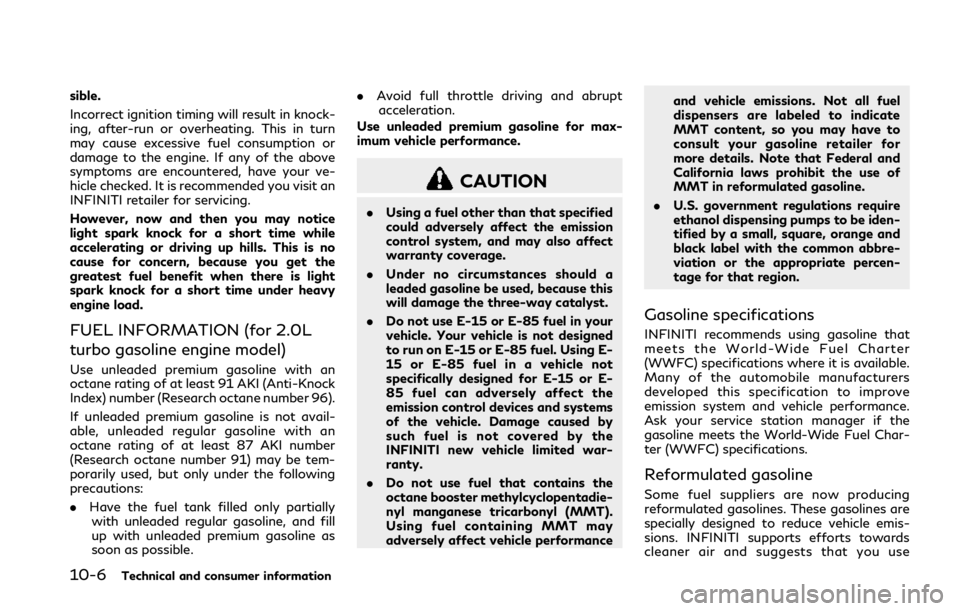
10-6Technical and consumer information
sible.
Incorrect ignition timing will result in knock-
ing, after-run or overheating. This in turn
may cause excessive fuel consumption or
damage to the engine. If any of the above
symptoms are encountered, have your ve-
hicle checked. It is recommended you visit an
INFINITI retailer for servicing.
However, now and then you may notice
light spark knock for a short time while
accelerating or driving up hills. This is no
cause for concern, because you get the
greatest fuel benefit when there is light
spark knock for a short time under heavy
engine load.
FUEL INFORMATION (for 2.0L
turbo gasoline engine model)
Use unleaded premium gasoline with an
octane rating of at least 91 AKI (Anti-Knock
Index) number (Research octane number 96).
If unleaded premium gasoline is not avail-
able, unleaded regular gasoline with an
octane rating of at least 87 AKI number
(Research octane number 91) may be tem-
porarily used, but only under the following
precautions:
.Have the fuel tank filled only partially
with unleaded regular gasoline, and fill
up with unleaded premium gasoline as
soon as possible. .
Avoid full throttle driving and abrupt
acceleration.
Use unleaded premium gasoline for max-
imum vehicle performance.
CAUTION
. Using a fuel other than that specified
could adversely affect the emission
control system, and may also affect
warranty coverage.
. Under no circumstances should a
leaded gasoline be used, because this
will damage the three-way catalyst.
. Do not use E-15 or E-85 fuel in your
vehicle. Your vehicle is not designed
to run on E-15 or E-85 fuel. Using E-
15 or E-85 fuel in a vehicle not
specifically designed for E-15 or E-
85 fuel can adversely affect the
emission control devices and systems
of the vehicle. Damage caused by
such fuel is not covered by the
INFINITI new vehicle limited war-
ranty.
. Do not use fuel that contains the
octane booster methylcyclopentadie-
nyl manganese tricarbonyl (MMT).
Using fuel containing MMT may
adversely affect vehicle performance and vehicle emissions. Not all fuel
dispensers are labeled to indicate
MMT content, so you may have to
consult your gasoline retailer for
more details. Note that Federal and
California laws prohibit the use of
MMT in reformulated gasoline.
. U.S. government regulations require
ethanol dispensing pumps to be iden-
tified by a small, square, orange and
black label with the common abbre-
viation or the appropriate percen-
tage for that region.
Gasoline specifications
INFINITI recommends using gasoline that
meets the World-Wide Fuel Charter
(WWFC) specifications where it is available.
Many of the automobile manufacturers
developed this specification to improve
emission system and vehicle performance.
Ask your service station manager if the
gasoline meets the World-Wide Fuel Char-
ter (WWFC) specifications.
Reformulated gasoline
Some fuel suppliers are now producing
reformulated gasolines. These gasolines are
specially designed to reduce vehicle emis-
sions. INFINITI supports efforts towards
cleaner air and suggests that you use
Page 440 of 458
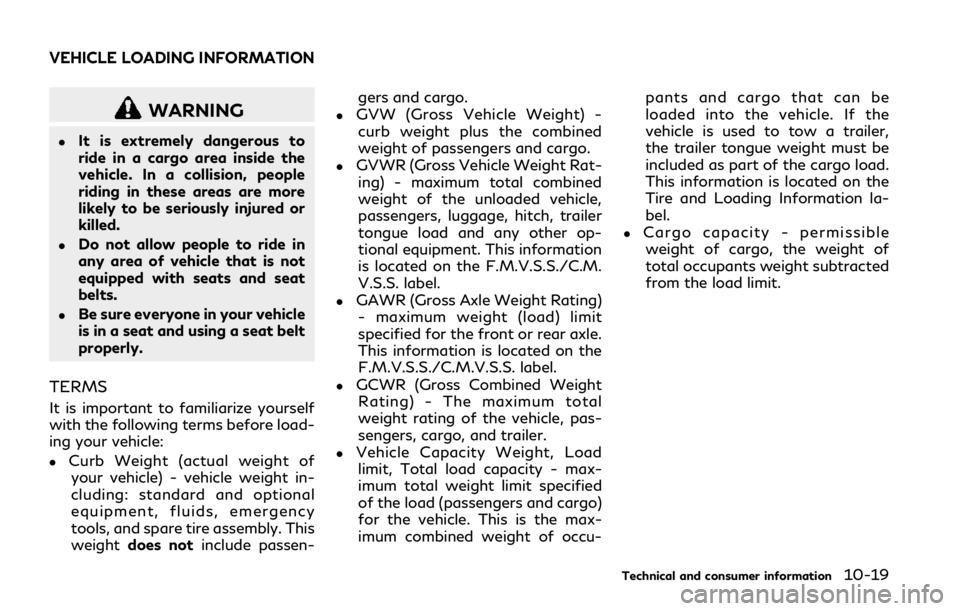
WARNING
.It is extremely dangerous to
ride in a cargo area inside the
vehicle. In a collision, people
riding in these areas are more
likely to be seriously injured or
killed.
.Do not allow people to ride in
any area of vehicle that is not
equipped with seats and seat
belts.
.Be sure everyone in your vehicle
is in a seat and using a seat belt
properly.
TERMS
It is important to familiarize yourself
with the following terms before load-
ing your vehicle:
.Curb Weight (actual weight ofyour vehicle) - vehicle weight in-
cluding: standard and optional
equipment, fluids, emergency
tools, and spare tire assembly. This
weight does not include passen- gers and cargo.
.GVW (Gross Vehicle Weight) -
curb weight plus the combined
weight of passengers and cargo.
.GVWR (Gross Vehicle Weight Rat-ing) - maximum total combined
weight of the unloaded vehicle,
passengers, luggage, hitch, trailer
tongue load and any other op-
tional equipment. This information
is located on the F.M.V.S.S./C.M.
V.S.S. label.
.GAWR (Gross Axle Weight Rating)- maximum weight (load) limit
specified for the front or rear axle.
This information is located on the
F.M.V.S.S./C.M.V.S.S. label.
.GCWR (Gross Combined Weight
Rating) - The maximum total
weight rating of the vehicle, pas-
sengers, cargo, and trailer.
.Vehicle Capacity Weight, Loadlimit, Total load capacity - max-
imum total weight limit specified
of the load (passengers and cargo)
for the vehicle. This is the max-
imum combined weight of occu- pants and cargo that can be
loaded into the vehicle. If the
vehicle is used to tow a trailer,
the trailer tongue weight must be
included as part of the cargo load.
This information is located on the
Tire and Loading Information la-
bel.
.Cargo capacity - permissible
weight of cargo, the weight of
total occupants weight subtracted
from the load limit.
Technical and consumer information10-19
VEHICLE LOADING INFORMATION
Page 441 of 458

10-20Technical and consumer information
STI0365
VEHICLE LOAD CAPACITY
Do not exceed the load limit of your
vehicle shown as “The combined
weight of occupants and cargo” on
the Tire and Loading Information
label. Do not exceed the number of
occupants shown as “Seating Capa-
city” on the Tire and Loading Infor-
mation label.
To get “the combined weight of
occupants and cargo”, add the weight
of all occupants, then add the total
luggage weight. Examples are shownin the illustration.Steps for determining correct load
limit
1.Locate the statement “The com-
bined weight of occupants and
cargo should never exceed XXX
kg or XXX lbs” on your vehicle’s
placard.
2.Determine the combined weight of
the driver and passengers that will
be riding in your vehicle.
3.Subtract the combined weight of
the driver and passengers fromXXX kg or XXX lbs.
4.The resulting figure equals the
available amount of cargo and
luggage load capacity. For exam-
ple, if the XXX amount equals
1400 lbs. and there will be five
150 lb. passengers in your vehicle,
the amount of available cargo and
luggage load capacity is 650 lbs.
(1400 − 750 (5 x 150) = 650 lbs or
640 − 340 (5 x 70) = 300 kg.)
5.Determine the combined weight of
luggage and cargo being loaded on
the vehicle. That weight may not
safely exceed the available cargo
and luggage load capacity calcu-
lated in Step 4.
6.If your vehicle will be towing a
trailer, load from your trailer will
be transferred to your vehicle.
Consult this manual to determine
how this reduces the available
cargo and luggage load capacity
of your vehicle.
Before driving a loaded vehicle, con-
firm that you do not exceed the Gross
Vehicle Weight Rating (GVWR) or the
Page 443 of 458
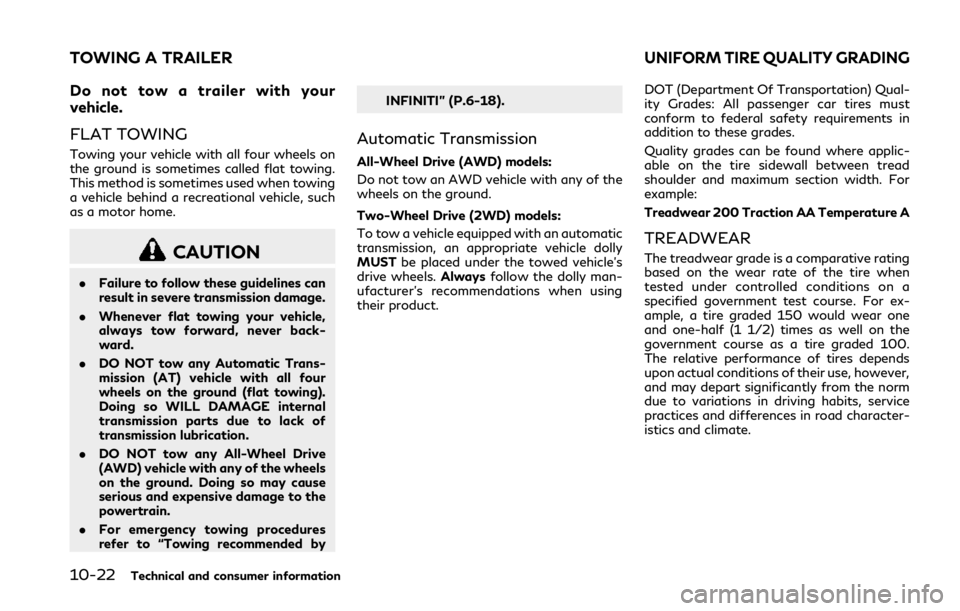
10-22Technical and consumer information
Do not tow a trailer with your
vehicle.
FLAT TOWING
Towing your vehicle with all four wheels on
the ground is sometimes called flat towing.
This method is sometimes used when towing
a vehicle behind a recreational vehicle, such
as a motor home.
CAUTION
.Failure to follow these guidelines can
result in severe transmission damage.
. Whenever flat towing your vehicle,
always tow forward, never back-
ward.
. DO NOT tow any Automatic Trans-
mission (AT) vehicle with all four
wheels on the ground (flat towing).
Doing so WILL DAMAGE internal
transmission parts due to lack of
transmission lubrication.
. DO NOT tow any All-Wheel Drive
(AWD) vehicle with any of the wheels
on the ground. Doing so may cause
serious and expensive damage to the
powertrain.
. For emergency towing procedures
refer to “Towing recommended by INFINITI” (P.6-18).
Automatic Transmission
All-Wheel Drive (AWD) models:
Do not tow an AWD vehicle with any of the
wheels on the ground.
Two-Wheel Drive (2WD) models:
To tow a vehicle equipped with an automatic
transmission, an appropriate vehicle dolly
MUST
be placed under the towed vehicle’s
drive wheels. Alwaysfollow the dolly man-
ufacturer’s recommendations when using
their product. DOT (Department Of Transportation) Qual-
ity Grades: All passenger car tires must
conform to federal safety requirements in
addition to these grades.
Quality grades can be found where applic-
able on the tire sidewall between tread
shoulder and maximum section width. For
example:
Treadwear 200 Traction AA Temperature A
TREADWEAR
The treadwear grade is a comparative rating
based on the wear rate of the tire when
tested under controlled conditions on a
specified government test course. For ex-
ample, a tire graded 150 would wear one
and one-half (1 1/2) times as well on the
government course as a tire graded 100.
The relative performance of tires depends
upon actual conditions of their use, however,
and may depart significantly from the norm
due to variations in driving habits, service
practices and differences in road character-
istics and climate.
TOWING A TRAILERUNIFORM TIRE QUALITY GRADING
Page 449 of 458
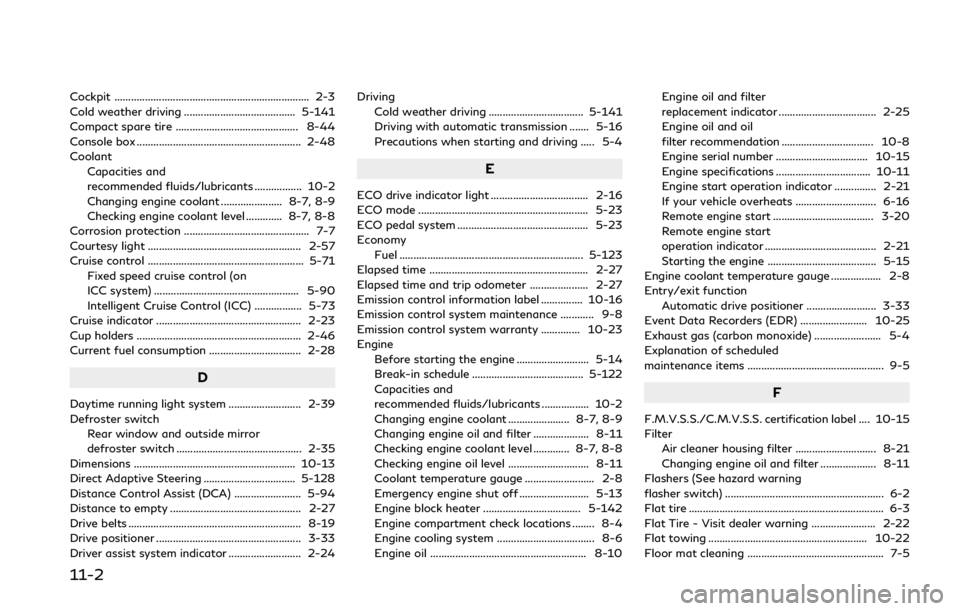
11-2
Cockpit ...................................................................... 2-3
Cold weather driving ........................................ 5-141
Compact spare tire ............................................ 8-44
Console box ........................................................... 2-48
CoolantCapacities and
recommended fluids/lubricants ................. 10-2
Changing engine coolant ...................... 8-7, 8-9
Checking engine coolant level ............. 8-7, 8-8
Corrosion protection ............................................. 7-7
Courtesy light ....................................................... 2-57
Cruise control ........................................................ 5-71 Fixed speed cruise control (on
ICC system) .................................................... 5-90
Intelligent Cruise Control (ICC) ................. 5-73
Cruise indicator .................................................... 2-23
Cup holders ........................................................... 2-46
Current fuel consumption ................................. 2-28
D
Daytime running light system .......................... 2-39
Defroster switch
Rear window and outside mirror
defroster switch ............................................. 2-35
Dimensions .......................................................... 10-13
Direct Adaptive Steering ................................. 5-128
Distance Control Assist (DCA) ........................ 5-94
Distance to empty ............................................... 2-27
Drive belts .............................................................. 8-19
Drive positioner .................................................... 3-33
Driver assist system indicator .......................... 2-24 Driving
Cold weather driving .................................. 5-141
Driving with automatic transmission ....... 5-16
Precautions when starting and driving ..... 5-4
E
ECO drive indicator light ................................... 2-16
ECO mode ............................................................. 5-23
ECO pedal system ............................................... 5-23
Economy Fuel .................................................................. 5-123
Elapsed time ......................................................... 2-27
Elapsed time and trip odometer ..................... 2-27
Emission control information label ............... 10-16
Emission control system maintenance ............ 9-8
Emission control system warranty .............. 10-23
Engine Before starting the engine .......................... 5-14
Break-in schedule ........................................ 5-122
Capacities and
recommended fluids/lubricants ................. 10-2
Changing engine coolant ...................... 8-7, 8-9
Changing engine oil and filter .................... 8-11
Checking engine coolant level ............. 8-7, 8-8
Checking engine oil level ............................. 8-11
Coolant temperature gauge ......................... 2-8
Emergency engine shut off ......................... 5-13
Engine block heater ................................... 5-142
Engine compartment check locations ........ 8-4
Engine cooling system ................................... 8-6
Engine oil ........................................................ 8-10 Engine oil and filter
replacement indicator ................................... 2-25
Engine oil and oil
filter recommendation ................................. 10-8
Engine serial number ................................. 10-15
Engine specifications .................................. 10-11
Engine start operation indicator ............... 2-21
If your vehicle overheats ............................. 6-16
Remote engine start .................................... 3-20
Remote engine start
operation indicator ........................................ 2-21
Starting the engine ....................................... 5-15
Engine coolant temperature gauge .................. 2-8
Entry/exit function Automatic drive positioner ......................... 3-33
Event Data Recorders (EDR) ........................ 10-25
Exhaust gas (carbon monoxide) ........................ 5-4
Explanation of scheduled
maintenance items ................................................. 9-5
F
F.M.V.S.S./C.M.V.S.S. certification label .... 10-15
Filter Air cleaner housing filter ............................. 8-21
Changing engine oil and filter .................... 8-11
Flashers (See hazard warning
flasher switch) ......................................................... 6-2
Flat tire ...................................................................... 6-3
Flat Tire - Visit dealer warning ....................... 2-22
Flat towing ......................................................... 10-22
Floor mat cleaning ................................................. 7-5
Page 454 of 458
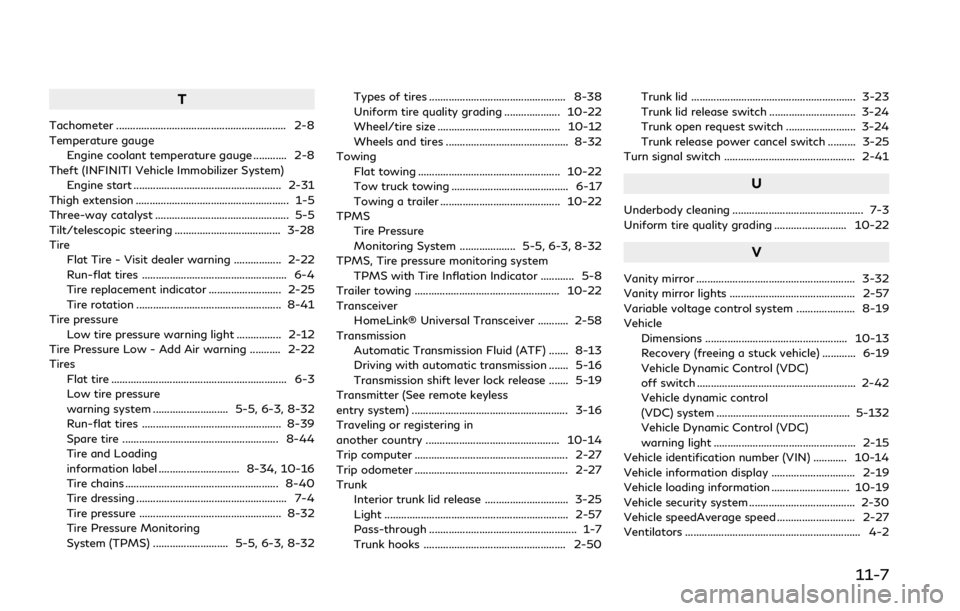
T
Tachometer ............................................................. 2-8
Temperature gaugeEngine coolant temperature gauge ............ 2-8
Theft (INFINITI Vehicle Immobilizer System)
Engine start ..................................................... 2-31
Thigh extension ....................................................... 1-5
Three-way catalyst ................................................ 5-5
Tilt/telescopic steering ...................................... 3-28
Tire Flat Tire - Visit dealer warning ................. 2-22
Run-flat tires .................................................... 6-4
Tire replacement indicator .......................... 2-25
Tire rotation .................................................... 8-41
Tire pressure
Low tire pressure warning light ................ 2-12
Tire Pressure Low - Add Air warning ........... 2-22
Tires
Flat tire ............................................................... 6-3
Low tire pressure
warning system ........................... 5-5, 6-3, 8-32
Run-flat tires .................................................. 8-39
Spare tire ........................................................ 8-44
Tire and Loading
information label ............................. 8-34, 10-16
Tire chains ....................................................... 8-40
Tire dressing ...................................................... 7-4
Tire pressure ................................................... 8-32
Tire Pressure Monitoring
System (TPMS) ........................... 5-5, 6-3, 8-32 Types of tires ................................................. 8-38
Uniform tire quality grading .................... 10-22
Wheel/tire size ............................................ 10-12
Wheels and tires ............................................ 8-32
Towing Flat towing ................................................... 10-22
Tow truck towing .......................................... 6-17
Towing a trailer ........................................... 10-22
TPMS Tire Pressure
Monitoring System .................... 5-5, 6-3, 8-32
TPMS, Tire pressure monitoring system TPMS with Tire Inflation Indicator ............ 5-8
Trailer towing .................................................... 10-22
Transceiver HomeLink® Universal Transceiver ........... 2-58
Transmission Automatic Transmission Fluid (ATF) ....... 8-13
Driving with automatic transmission ....... 5-16
Transmission shift lever lock release ....... 5-19
Transmitter (See remote keyless
entry system) ........................................................ 3-16
Traveling or registering in
another country ................................................ 10-14
Trip computer ....................................................... 2-27
Trip odometer ....................................................... 2-27
Trunk Interior trunk lid release .............................. 3-25
Light .................................................................. 2-57
Pass-through ..................................................... 1-7
Trunk hooks ................................................... 2-50 Trunk lid ........................................................... 3-23
Trunk lid release switch ............................... 3-24
Trunk open request switch ......................... 3-24
Trunk release power cancel switch .......... 3-25
Turn signal switch ............................................... 2-41
U
Underbody cleaning ............................................... 7-3
Uniform tire quality grading .......................... 10-22
V
Vanity mirror ......................................................... 3-32
Vanity mirror lights ............................................. 2-57
Variable voltage control system ..................... 8-19
Vehicle Dimensions ................................................... 10-13
Recovery (freeing a stuck vehicle) ............ 6-19
Vehicle Dynamic Control (VDC)
off switch ......................................................... 2-42
Vehicle dynamic control
(VDC) system ................................................ 5-132
Vehicle Dynamic Control (VDC)
warning light ................................................... 2-15
Vehicle identification number (VIN) ............ 10-14
Vehicle information display .............................. 2-19
Vehicle loading information ............................ 10-19
Vehicle security system ...................................... 2-30
Vehicle speedAverage speed ............................ 2-27
Ventilators ............................................................... 4-2
11-7